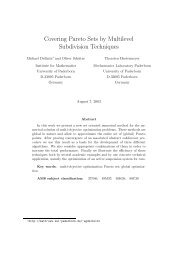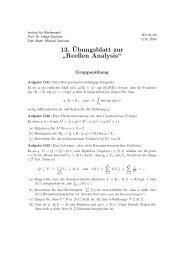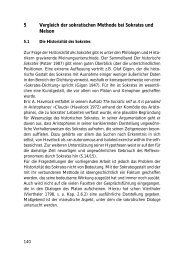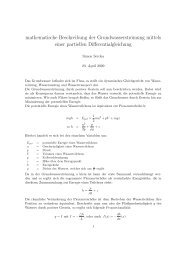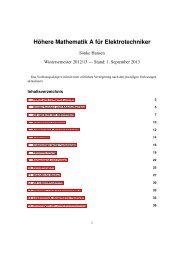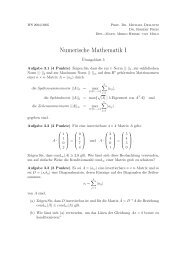Partial Differential Equations
Partial Differential Equations
Partial Differential Equations
You also want an ePaper? Increase the reach of your titles
YUMPU automatically turns print PDFs into web optimized ePapers that Google loves.
48 2 First Order <strong>Equations</strong><br />
with functions b: U ×R → R n and c: U ×R → R. Then, F (p, z, x) = b(x, z)·p+c(x, z) and D p F (p, z, x) =<br />
b(x, z). Then, the characteristic equation for x(s) is given by<br />
The characteristic equation for z(s) gets to<br />
dx<br />
(s) = b(x(s), z(s)).<br />
ds<br />
dz<br />
(s) = b(x(s), z(s)) · p(s) = −c(x(s), z(s)).<br />
ds<br />
Again, the characteristic equation for p(s) is not needed.<br />
Example 2.2.5. Consider the boundary value problem<br />
{<br />
ux1 + u x2 = u 2 on U = {x ∈ R 2 | x 2 > 0},<br />
u = g<br />
on Γ = {x ∈ R 2 | x 2 = 0} ⊆ ∂U,<br />
i.e., we set b(x, z) = (1, 1) and c(x, z) = −z 2 in the notation of Example 2.2.4. Thus, the characteristic<br />
equations for x and z are<br />
⎧<br />
dx 1<br />
ds<br />
(s) = 1,<br />
⎪⎨<br />
(s) = 1,<br />
dx 2<br />
ds<br />
and one gets the solutions<br />
⎪⎩ dz<br />
ds (s) = z(s)2 ,<br />
⎧<br />
x 1 (s) = γ + s,<br />
⎪⎨<br />
x 2 (s) = s,<br />
⎪⎩<br />
z(s) = δ<br />
1−sδ =<br />
g(γ,0)<br />
1−sg(γ,0)<br />
z<br />
x 2<br />
c<br />
x<br />
1<br />
Fig. 2.8. u(x, y) = sin ( )<br />
(x 2 + y 2 ) 1 2 e<br />
arctan( y x )<br />
for s ≥ 0 with γ ∈ R. For x = (x 1 , x 2 ) ∈ U, we now choose γ and s such that<br />
We obtain<br />
so that<br />
(x 1 , x 2 ) = (x 1 (s), x 2 (s)) = (γ + s, s).<br />
γ = x 1 − x 2 and s = x 2 ,<br />
u(x 1 , x 2 ) = u(x 1 (s), x 2 (s)) = z(s) =<br />
=<br />
g(x 1 − x 2 , 0)<br />
1 − x 2 g(x 1 − x 2 , 0) .<br />
g(c, 0)<br />
1 − sg(c, 0)<br />
Evidently, this solution only make sense if one does not pass the singularity g(x 1 − x 2 , 0) = 1 x 2<br />
.




